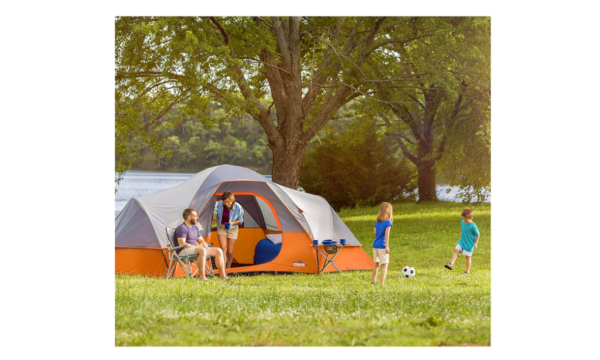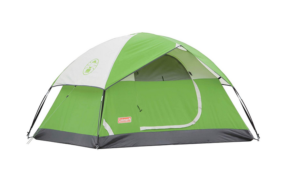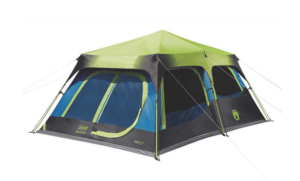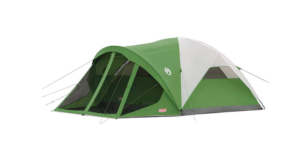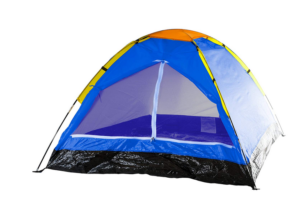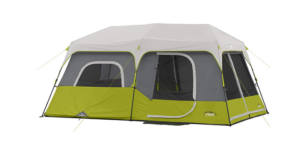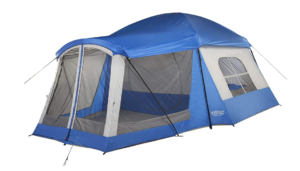Camping with tents. This will comprehensively cover camping tents on sale, pop up, large, with lights, with rooms, with screen porch, tents to rent, with shower, Luxury tents, with heaters, waterproof, rooftop tent camping, tents for camping with dogs, and more
Many people are embracing the outdoor lifestyle and the popularity of camping with tents has increased with the falling prices of the best camping tents. Outdoor camping with tents does wonders and helps improve your mental wellness by shaking off any stress you may be experiencing in your daily life.
Outdoor tent camping is done with friends or family. It is a fun activity that provides hours of enjoyment and an opportunity for loved ones to connect with each other as well as with nature.
When planning for a camping adventure, it is important to get a quality camping tent that will adequately accommodate all of you because a camping tent can make or break your vacation.
Large camping tents are ideal for group camping with friends and family while small camping tents are ideal for 2 or 3 people. Small camping tents are less prone to wind damage, lightweight and compact, and easier to find a camping site for.
If backcountry travel is more important than interior space and camping comfort, small backpacking tents are ideal for you. However, if you plan on backpacking with your camping tent, it is important that you choose a tent that is lightweight.
Camping with Tents- Best Tents Quick GuideCamping Tents with Heaters Large Tents for camping Camping Tents for Winter Camping Tents with Lights Beds for Camping Tents Best Camping Cots Best camping hammocks
|
Camping with Tents Tips
- If you are going camping at a place where many people camp, getting there early is the best strategy for getting a perfect campsite. Avoid places with Narrow canyons for the risk of flooding, open fields for lone camping, clay soils because of poor drainage, cliffs and ledges that are very dangerous, and areas with stagnant water because of biting insects.
- Ensure you pack everything you need when going camping. Rain jackets, windbreakers, mosquito shields, camping beds, torch, lighting, matches, and more.
- Always ensure that your matchbox is dry, lighting fires can be a problem when the matches get wet
- Camping gear such as clothes, shoes, and more
- Camping requires you to dress in layers depending on the weather and climate, if it’s cold, the more you will and as it gets warm you shed off some clothing.
- Pack insulated mugs with lids for food insulation and to prevent insects from getting into your food
- Get a solar-heated camp shower bag for showering, hand rinsing, and cleaning utensils
- Collect enough firewood, to avoid missing out, as firewood can be scarce in some camping locations
- Remember to pack toilet paper.
- Be considerate of those camping around you. Don’t do anything you wouldn’t want your fellow campers doing to you
- Camp near water, but not too near.
- Clean up when you leave
Camping with Tents Essentials/ Checklist
- Shelter/ Tents
- Water
- Survival/ Tactical Knife
- Medical supplies/ First Aid Kit
- Sleeping Bags/ Blankets/ Camping Beds
- Warm and Rainproof Clothing
- Insect repellers/ Nets
- Camping Chairs and Tables
- Firewood
- Containers with lids and Airtight
- Sunscreen
- Cooler for camping
- Survival Gear and Tools
- Camping Hammocks
- Camping Lights
- Toiletries
- Fire Starters
- Utensils for camping
- Stoves for Camping
- Heaters for Camping
Best Camping Tents on Sale
Coleman Camping TentsColeman Sundome Tent
See Latest Price
Features
Coleman Cabin Tent
Features
Coleman Dome Tent
Features
|
Wakeman 2-Person Dome Tent
Features
|
Core Camping TentsCORE 9 Person Instant Cabin Tent
Features
CORE 9 Person Extended Dome Tent
Features
|
Abco Tech Pop Up Tent
See Latest Price
Features
|
Wenzel 8 Person Klondike Tent
Features
|
What camping tent size is right for you?
To enjoy every bit of your camping adventure, you will need a spacious camping tent to stand up, stretch out and be comfortable in whether you are camping alone or sharing the space with family and friends.
Some tent manufacturers exaggerate how many people can comfortably fit in their tents. For instance, most 2-person tents are quite small to accommodate 2 averaged sized persons comfortably. The same happens to 3, 4, 6, and 8-person tents.
Therefore, it is important to size up when you are considering which tent model to buy. If you plan on going camping with a group of four people, it is probably a good choice to go for a 6 person tent size.
You will be sure that everyone will be comfortable and also have extra space where you can store your camping gear and other necessities.
What does camping with tents entail?
Camping involves setting up a home away from home, in the woods, parks, and club sites among other camping sites. You will be required to carry shelter and bedding to rest. Below are some of the important necessities you will need for your camping trip.
- Camping tent. Tents come in different sizes and shapes. Dome-shaped tents are quite popular because the most interior space. They are also lightweight making them ideal for backpacking. The size of the tent to carry depends on the number of people intended to sleep in the tent. Large-sized tents are spacious enough to accommodate at least 8 people while small-sized tents are capable of accommodating 2-3 people.
- Cooking supplies. If you love cooking when out camping, it is important to carry a few basic supplies which include a knife, chopping board, cooking grate, tongs or flippers, camping stove and fuel, cups, plates, and skillet pot. You may want to be selective in the cooking supplies you bring along to ensure that they fit in your backpack and are light enough to carry.
- Camping heaters. If you plan on camping during winter, it is important that you carry a camping heater. Cold temperatures at night is something you should never underestimate. Alongside a winter camping tent and cold weather sleeping bags, a tent heater will help keep you warm while camping.
- Camping lights. Lights are the most practical and useful feature in any camping tent. You can light up your camping tent using headlamps, tents lights or built-in LED lighting. However, illuminating your tent in the dark works best with a tent light, rather than a flashlight or camp lantern. Integrating tents and lighting brings out a whole new level of convenience, functionality, and comfort.
- First aid kit. You might end up being injured when preparing food or walking around in the dark. While hiking, you can accidentally get injured. You will need to have a first aid kit close in case such accidents happen.
- Camping bed. Comfortable camping beds make camping far more enjoyable. The best camping bed is one that fits you the best. With a quality camping bed, you will not only have a good night’s sleep, but you will also wake up refreshed and energized to tackle your next day’s adventure.
- Alternative weather gear. Weather patterns can change at the drop of a dime, leaving you stuck in the rain-soaked up. It is therefore important that you bring along an extra set of clothes so you won’t have to worry about sudden weather changes.
- Camping chair. Depending on your mode of travel to the campsite, you can carry a camping chair to enjoy your time at the camp. If you have a car, camping chairs choices are endless. A camping chair with a backrest is ideal as it offers nice back support. A camping chair is also important because you can place things such as books and bottles on it.
Advantages of Camping with Tents
- Portability
Most tents can be folded and packed within the other camping gear with ease. Camping tent designs have come a long way and you can easily find large tents that are lightweight and easy to carry. Compared with an RV (recreational vehicle) the amount of gas you spend while moving a tent is lower than that consumed in the case of an RV.
- Affordable
The initial budget for buying a camping tent is the cheapest among all other camping types. It might seem that you have to purchase a lot of things to have a comfortable stay, however nearly all of them are quite cost-effective and you can purchase them second-hand if you are tight on budget.
- Ease of access to the campsite.
Camping tents can be carried anywhere and set up in all campsites. They also occupy less space, unlike RVs which occupy a lot of space. As a result, not all campsites will be accessible through an RV and even if there are, there may not be enough parking space to park the RV.
- Ease of storage.
After you are done camping, most of the camping tents available on the market are easy to take down and fold then place it in its included carry bag.
- Availability
Tents for camping are readily available on the market. You can purchase a camping tent from a retailer available at your local place or order them online. Depending on where you search, you might be able to find a camping tent readily available.
- Camping experience.
The other benefit you get by camping in a traditional camping tent is the experience you get. Camping tents are like tarps. They give you protection from the outdoors, however, they still leave you feeling as if you are camping on an open night. If you are an outdoor enthusiast who is looking to get a camping experience they will never forget, you may want to think about camping in a traditional camping tent.
Disadvantages of Camping with Tents
Although camping in a traditional camping tent is nice and fun, there are a number of downsides that come with it. They are:
- Bad weather.
A large number of camping tents are strong and waterproof, bad weather such as heavy storms might hit you while camping, and your tent might not be strong enough to handle it.
- Set up.
A large number of modern camping tents are easy to set up and setting up can be done in a few minutes you will find tents that can be set up by one person. Nevertheless, setting up can be quite difficult if the person doing it hasn’t learnt how to do it before.
- Inconvenient
Camping tents don’t have a shower or a toilet. You will have to also use the common areas at the camping sites which can be quite inconvenient.
- Uncomfortable
The tent might not be spacious enough for everyone to fit in comfortably and it is quite uncomfortable to sleep in a tent than in a bungalow or a motor caravan. In addition, the tent might get too cold making it difficult for someone to sleep.
Factors considered when choosing a Camping Tent
- Comfortable size.
The tent you decide to choose should provide you with more comfort than just a shelter at your camping site. You should feel protected from bugs and crawling animals while in the tent sleeping or just relaxing. The height should also be comfortable enough such that adults can comfortably walk and stand.
- Resistant to storms.
If a storm suddenly comes due to bad weather conditions at the campsite, your camping tent should be able to keep you safe and comfortable. It should be made of strong and waterproof materials in order to be able to withstand any adverse weather conditions.
- Durability
The durability of any camping tent depends on the workmanship used while making it along with the quality of the materials used. The workmanship and materials used by different companies differ greatly.
- Easy to set up.
The tent you decide to buy should be easy to set up so that you can have adequate time to enjoy your vacation instead of spending too much time setting it up. It should not take more than 15 minutes to completely set up a tent including its stakeouts.
- Packing size.
The packing size of any camping tent is also important because you will have to adjust it along with other different gear you will need to carry along for your trip. Camping requires you to carry different things so you should focus on a packaging size that adjusts with the other things comfortably.
Where to pitch a Camping Tent
Setting up a tent can be extremely challenging and exhausting, especially for beginners. The location where you choose to pitch your tent will have a significant impact on comfort and safety. In order to enjoy your camping experience and avoid any disastrous set-up issues, below are the best spots where you can pitch a tent.
- Choose a flat ground.
You are more likely to have a comfortable night’s sleep and good rest in areas with sand, grass, or dirt, rather than littered with rocks and stones. When you find a flat space large enough to fit your tent, use a small rake to clean the space and remove any stones and sticks that might poke you when sleeping.
- Avoid hills.
Avoid setting up your tent anywhere on a hill, whether at the top, middle, or bottom of a hill because all these locations pose a threat to your safety. If you fail to find level ground and you decide to settle for a slightly sloping ground ensure that you position your head on the upper side with your feet facing downhill.
- Camping in the snow.
Avoid choosing a campsite near trees laden with loads of snow which may drop off when they melt or when the weather is windy. Once you locate a suitable place to set up the tent, use your snowshoes or skis to tamp down the ground to create a solid, firm surface.
- Camping in the forest.
Forests are the most popular sites for camping. You will find different soil types in different parts of a forest. Some soils are hard to penetrate with stakes while others are loamy and will not hold the stakes well. Conduct a little research on the soil type before you set off in order to determine the appropriate stakes to carry.
- Sun exposure.
Look for an area with shade. A tent positioned directly to the sun will become too hot and some tents can get damaged if exposed to too many sun rays.
Conclusion
If you are an outdoor enthusiast who is looking to get a camping experience they will never forget, you may want to think about camping in a traditional camping tent. Tents for camping are not only affordable but also readily available, therefore, everybody can own one.
